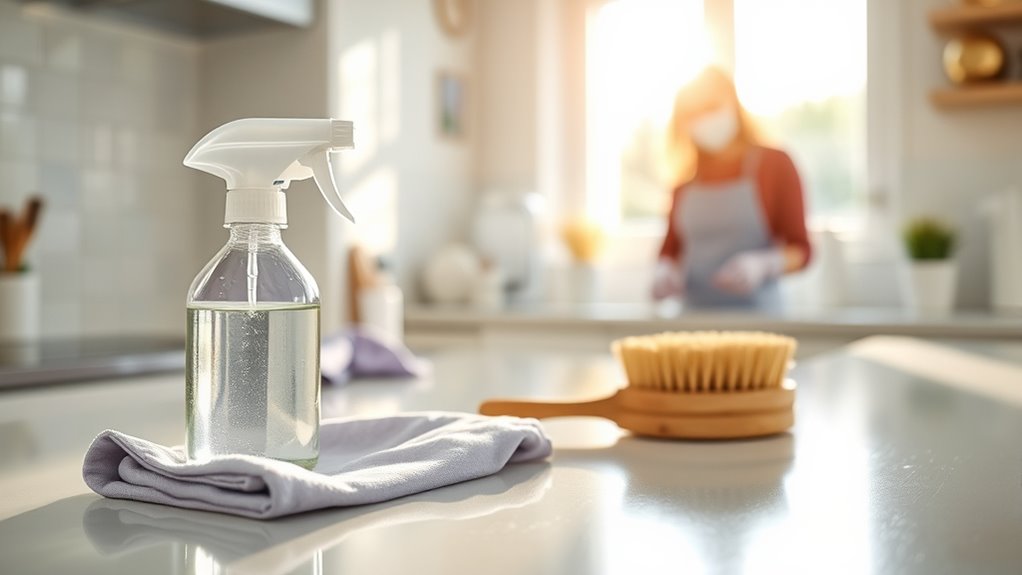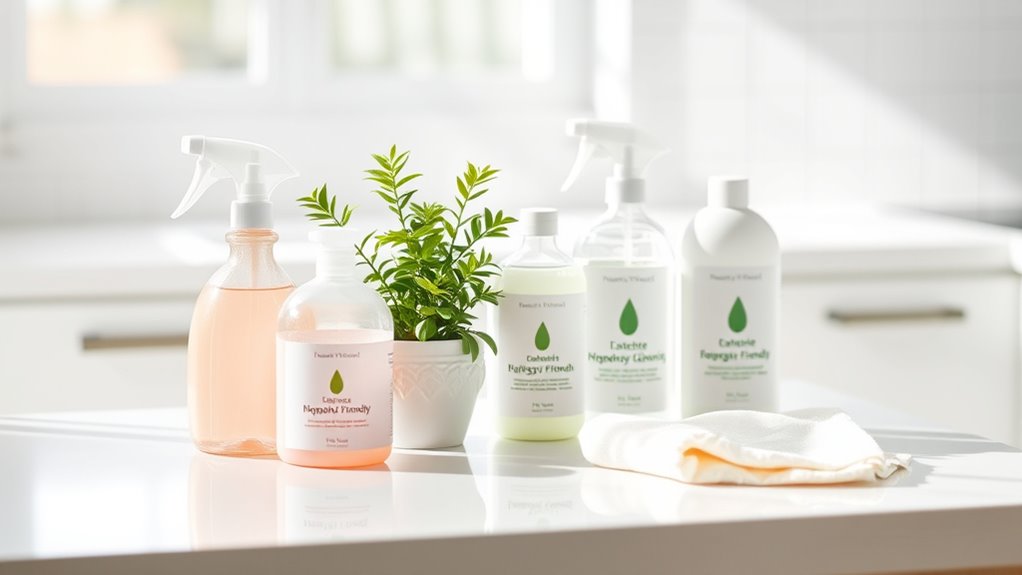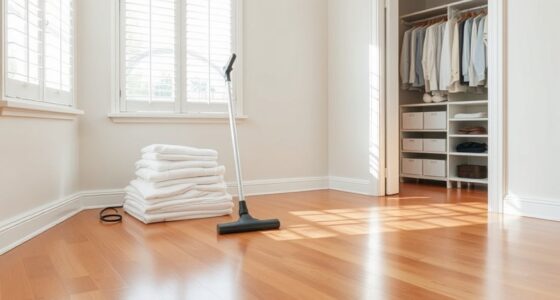To create an allergy-friendly cleaning routine, use hypoallergenic, fragrance-free products and keep surfaces disinfected with gentle cleaners. Wash bedding and fabrics weekly in hot water with hypoallergenic detergents, and vacuum with a HEPA filter to trap tiny allergens. Improve air quality by opening windows or using exhaust fans, and maintain your air purifier by regularly changing filters. Following these simple steps can greatly reduce allergy triggers—continue to explore ways to make your home even safer.
Key Takeaways
- Use hypoallergenic cleaning products and disinfectants to minimize allergen exposure during routine cleaning.
- Regularly wash bedding, curtains, and fabrics with hot water and hypoallergenic detergents to reduce dust mites.
- Vacuum with a HEPA-filter vacuum cleaner and clean filters frequently to trap airborne allergens effectively.
- Increase ventilation by opening windows or using exhaust fans during and after cleaning to disperse airborne particles.
- Maintain air purifiers with clean filters and replace them as recommended to ensure optimal indoor air quality.

Are you tired of sneezing and coughing every time you clean? If so, it’s time to rethink your cleaning routine with allergy-friendly practices. One of the most effective ways to reduce airborne allergens is by focusing on air purifier maintenance. Regularly checking and changing your air purifier filters guarantees it works efficiently, capturing dust, pollen, pet dander, and other irritants before they circulate through your home. Avoid neglecting this step, as a clogged or outdated filter can do more harm than good, pushing allergens back into the air you breathe. Alongside maintaining your air purifier, switching to hypoallergenic cleaning products makes a significant difference. These products are specially formulated to minimize or eliminate common allergens and harsh chemicals that can trigger reactions. Opt for brands that specify they’re hypoallergenic and fragrance-free to reduce the risk of irritation. Using these products means you can clean surfaces thoroughly without introducing new allergens or irritating residues.
When cleaning, pay close attention to frequently touched surfaces like doorknobs, light switches, and remote controls. Wipe them down with hypoallergenic disinfectants or gentle cleaning solutions to eliminate germs and allergens without leaving behind chemical residues that could worsen allergies. Vacuuming is another essential step, but it’s vital to choose a vacuum with a HEPA filter. This filter traps tiny particles like pollen and pet dander rather than just stirring them up into the air. Remember to replace or clean the vacuum filter regularly to keep it functioning properly. Additionally, wash bedding, curtains, and any fabric-covered furniture weekly using hot water and hypoallergenic detergents. This reduces the buildup of dust mites and other allergens that thrive in soft fabrics. Maintaining proper ventilation and air quality can further improve your environment, as air quality directly impacts allergy symptoms and overall health.
Incorporate natural cleaning methods when possible, such as using vinegar and baking soda, which are less likely to leave behind irritating chemicals. During cleaning sessions, make sure to open windows or turn on exhaust fans to increase ventilation, helping disperse airborne particles and refresh the air. Consistency is key, so stick to your allergy-friendly routine to see ongoing improvements in your indoor air quality. Remember, maintaining your air purifier and choosing hypoallergenic cleaning products are foundational steps that support a healthier, sneeze-free environment. With these simple adjustments, you’ll find cleaning becomes less of a chore and more of a way to create a sanctuary that’s safe and comfortable for your allergies.
Frequently Asked Questions
Are Natural Cleaning Products as Effective as Chemical Cleaners?
Yes, natural cleaning products with plant-based solutions can be as effective as chemical cleaners. They effectively remove dirt and grime without leaving harmful chemical residue behind. You might need to let them sit a bit longer on tough stains, but they’re safer for your health and the environment. Plus, they reduce exposure to harsh chemicals, making your cleaning routine gentler and more eco-friendly while still getting the job done well.
How Often Should I Clean to Reduce Allergens?
You should clean at least once a week to reduce allergen buildup effectively. Regular cleaning disrupts dust, pet dander, and other allergens from accumulating, improving your indoor air quality. Increase cleaning frequency if you have pets or allergies to specific substances. Use targeted methods like damp dusting and vacuuming with HEPA filters. Consistent cleaning helps maintain a healthier environment and minimizes allergy symptoms over time.
Can I Use Essential Oils Safely Around Allergy Sufferers?
Yes, you can use essential oils safely around allergy sufferers if you follow essential oil safety guidelines and consider allergy considerations. Always dilute essential oils properly and choose hypoallergenic options. Avoid strong scents that might trigger reactions, and test a small area first. Consult with an allergy specialist if you’re unsure. By taking these precautions, you can enjoy the benefits of essential oils without compromising allergy safety.
Do Air Purifiers Help With Indoor Allergy Control?
You might be surprised to find that air purifiers really do help with indoor allergy control, especially when you keep up with air purifier maintenance. Regularly replacing the HEPA filter ensures its effectiveness in capturing airborne allergens like pollen, pet dander, and dust mites. When your purifier works *at its best*, it creates a cleaner environment, reducing allergy symptoms and making your home a more comfortable space for allergy sufferers.
What Are the Best Storage Tips for Allergy-Friendly Cleaning Supplies?
You should focus on storage organization by using clear, airtight containers to keep cleaning supplies sealed and separate. Labeling techniques are essential; use waterproof labels to identify each product easily and prevent mix-ups. Store supplies in a dedicated, high, or out-of-reach cabinet to minimize exposure, especially if you or family members have allergies. Regularly check for expired items and keep everything tidy for safe, effective allergy-friendly cleaning.
Conclusion
By following this allergy-friendly cleaning routine, you create a fresh, breathable sanctuary where dust and allergens no longer linger. Imagine opening your windows to a crisp breeze, the scent of clean surfaces filling every corner. With each sweep and wipe, you’re banishing invisible irritants, leaving behind a space that feels as light and inviting as a sunlit morning. Keep it simple, stay consistent, and enjoy the peaceful, allergen-free environment you’ve worked so hard to achieve.









